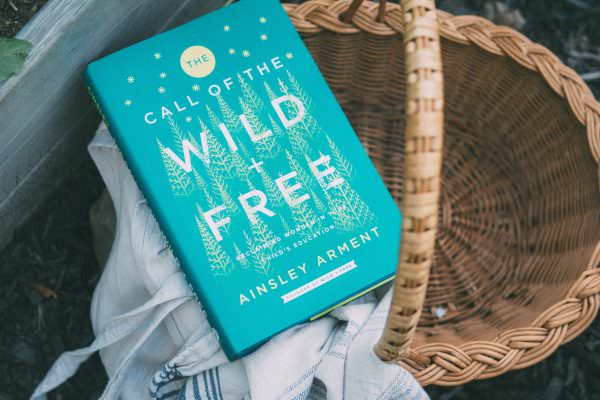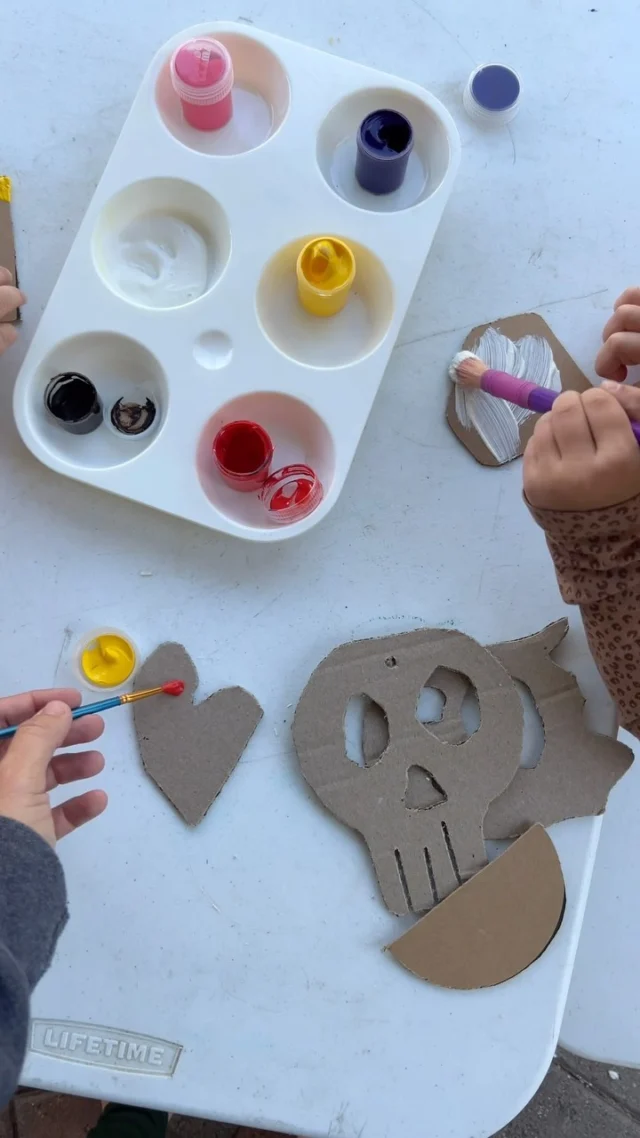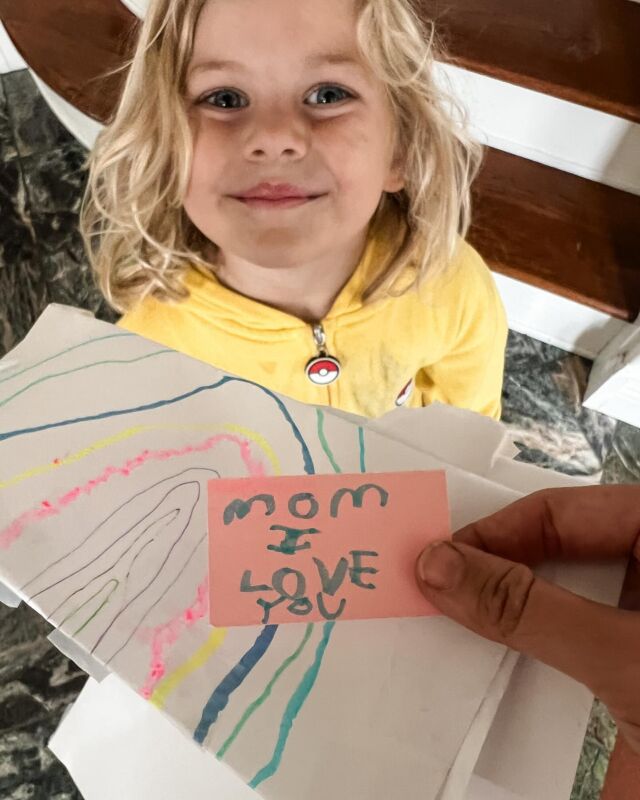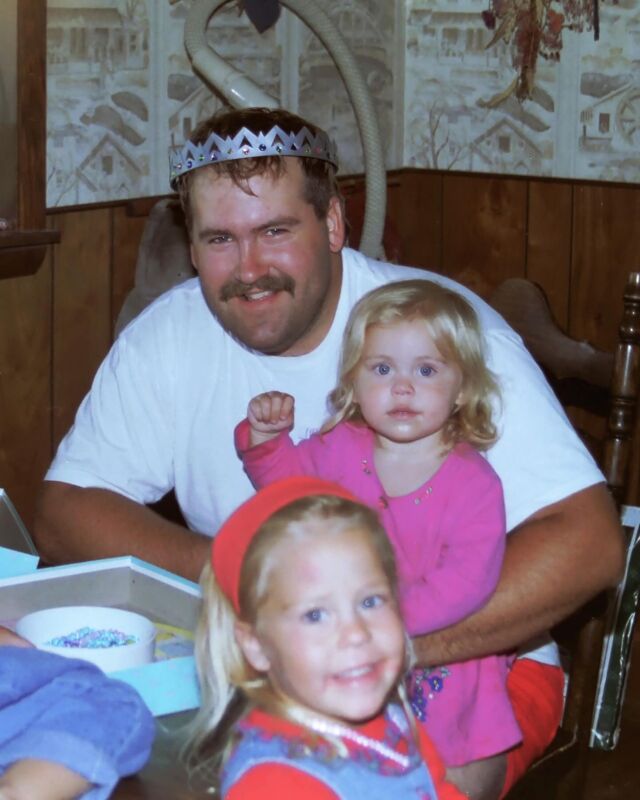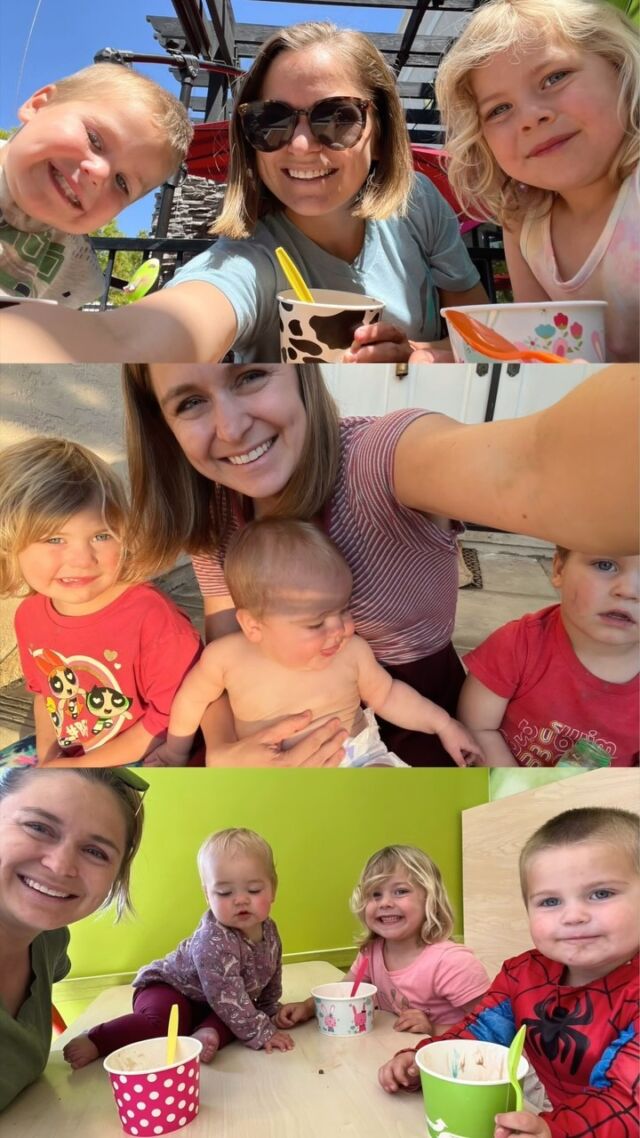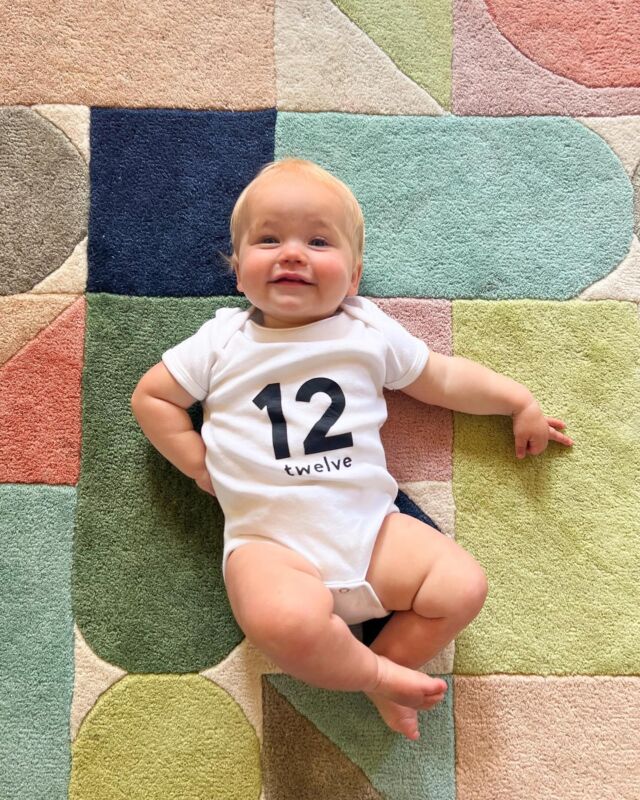When I began considering homeschooling, I decided to read The Call of the Wild & Free since I was intrigued through the things they offer as a membership, conference, and it felt like the vibe I was going for. And it was the absolute perfect book to begin my deep dive into homeschool research because it lays out a lot of different homeschool styles right for the reader!
Homeschool an Extension of Parenting
I see homeschooling as really just an extension of parenting. It is a lifestyle. I am drawn to the beauty, freedom, and organic way of learning.
“The goal of early childhood education should be to activate the child’s own desire to learn.”
There is nothing more natural to a mother’s heart than to look after the needs of her own children, to preserve their childhoods, and to give them the chance to be who they were made to be.
I wanted to give them a childhood. And I want to experience it with them.
We homeschool in order to make the world our classroom, to do more than what the classroom can provide, to go beyond what the conventional institutions of education can offer us.
“Homeschooling is more about creating good working habits than about academic learning. It’s more about nurturing our children.”
Observation — Knowing My Child
Be able to observe and understand my children so well. You can watch them, study them, learn their quirks and eccentricities. You can discover what makes them tick, what makes them frustrated, and what lights them up. And you can love them and believe in them like no one else ever could. Because you know them best.
You began to study your child from the time he was born, watching his mannerisms, how he acted and reacted, what made him tick.
It may take some time to figure out your style, but by understanding your unique approach, you’ll create a rich environment for learning. But remember, it isn’t just about you. Many parents think about how they personally, not their children, are wired. While it’s important to feel passionate about our teaching style, it’s equally important to consider how our children learn. When you understand how your child learns, you can create lessons that are project based, literature driven, hands-on, visual, or a combination of approaches.
It inspired me to go home and be a better mother, to listen with not just my ears but my whole being.
Remembering the Individuality of each Child
We get to understand how our children are wired and then adapt their education to their personalities. We get to value who they are and meet them where they’re at. So observe them. Study them. Watch how they express themselves, and take note.
Mothers with multiples can find it difficult not to mother them like a herd. You have to work hard to carve out quality time with each child since most of the time it’s group outings.
A desire to know and understand each particular child as an individual.
5 Love Languages
When they feel secure in their value, when they know they’re cherished, their hearts are joyful, more compliant. The day goes better. A child who is well loved is a delight to educate.
“Education is not the filling of a pail, but the lighting of a fire.”
Plutarch
Our children need our time, not our intelligence. They bloom with love, not perfect language skills. They need mercy, not intellectual mastery.
“The more slowly trees grow at first, the sounder they are at the core, and I think the same is true of human beings.”
Conventional School Learning
Life in a rat race. an endless race—to the bus stop, to the next reading level, to Christmas break, to the finish line. the rat race, driving kids to and from school, juggling little ones and class parties, rushing home to meet the bus, getting homework done, and taking the boys to soccer practice on time.
Studies show that the average family spends only thirty-six minutes together each day. Homeschooling is a return to parent-child mentorship. It brings us closer than anything else ever will.
“Children are not miniature adults. Requesting them to learn how to deal with adult levels of pressure is not good teaching—or parenting.”
Just as the frog in the pot doesn’t feel the temperature slowly rising, families have been slow to sense the increasing pressures heaped upon their kids in education. Days became captive to the schedule and system assigned to us.
Instruction is requiring our children to memorize facts and information. It comes from the outside in. Learning, on the other hand, is applying knowledge to their life in meaningful, life-changing ways. It happens from the inside out.
Imagine education being driven by passion instead of pressure.
The trouble with our modern version of childhood is that it strongly resembles the lifestyle of adults and comes at the expense of play.
Do some kids thrive in more structured environments? Of course. I’ve got a few of them. I’ve learned to make charts and create schedules for my more organized children, and I’ve learned not to care if my other kids wake up late or read fewer books than assigned. My kids are not all going to learn or thrive at the same pace, and I trust the natural learning process.
The key to this transformation is not to standardize education but to personalize it, to build achievement on discovering the individual talents of each child, to put students in an environment where they want to learn.
“Notice the difference: a child’s disability is the focus in traditional classroom settings, but his abilities are the focus in the homeschool environment.”
Have you heard the story of the woman who prepared a Christmas ham each year by first cutting off the end and throwing it away? Year after year, her husband and children watched her repeat this ritual until, finally, they asked her why she did it. She said her mother had taught her to do it. Why, she had no idea. They asked Grandma why she did it, but she couldn’t tell them either. Her own mother had done it for years. Finally, they asked Great-Grandma, the originator of the practice, and she provided a simple answer—the ham was too big for the pot she owned.
Generation after generation, we’ve been conditioned to believe that education must be carried out in a certain way, so we refuse to give homeschooling a try, even though we have no reason why.
This is not to say that conventional schools can’t help your child. But you’re gambling on the hope that someone will work with and care as much about your child as you do. If you’re waiting for someone to step in and give your child what she needs, it just might be you, Mama.
A family culture offers a framework for your children to thrive, a sense of identity, values to uphold, and traditions to honor. It’s the difference between becoming who you were meant to be and becoming what society wants to shape you into. And oh, does society have a plan for your life. It offers a ready-made, cookie-cutter approach that will shape you into the mold of every other stressed-out, overextended family out there. It will require less work, less thought, and less guilt than forging your own path. You simply plug in to the system and let it do its thing.
Becoming a Homeschooling Parent
Parenting is fraught with distractions, chaos, and tension. But it’s not accurate to say that homeschooling is an especially worsened case of it. Those emotions and tensions are all happening between a child and a parent whether you’re there for it or not. As homeschoolers, we have the ability to work through it with them and grow in our relationships.
Some things don’t get done or look the way I’d prefer. But homeschooling gives us the opportunity to involve our kids in these daily household chores. It teaches them how to work and learn housekeeping skills, and it reminds them that we’re all in this together. Homeschooling is a team effort. We are not doing this to them but with them.
Being mindful of children’s needs and supporting our children’s interests is vastly different from catering to their every whim, emotion, and desire.
Exemplar of Good Characteristics
Gives us more time to practice, make mistakes, apologize, and make amends. More practice for both parties towards character-strengthening values.
We create a safe family culture by saying we’re sorry when we’re wrong. Parents aren’t perfect. Saying “I’m sorry” makes us human. It puts us at the same level as our children and helps them know that they can be sorry too.
As a homeschool mother, get used to apologizing. The sheer amount of concentrated time you spend with your children will compound the number of infractions for which apologies will be needed.
I don’t see this as sacrificing my best years by devoting time to them. These are my best years. I can’t imagine anything more rewarding than shaping another human’s life and building a legacy.
Trusting I Can Teach My Children
It takes courage to homeschool, especially when society questions your every move. Taking your child out of traditional schooling to bring them home poses a different dynamic that can be intimidating to a lot of parents.
For now, we are their guides, albeit flawed. We are doing our best to form healthy habits alongside them, so they will learn how to do this for themselves as they grow in maturity.
We must trust that we have what it takes to teach our children at home. And certainly not because you have a limitless amount of patience. You are your child’s best teacher because you can lead by example. You can show them how to pursue knowledge by doing so yourself. You can join them on this learning journey as a guide through life and education, and sometimes the other way around.
I can tap into my natural gifts and follow my heart in raising my children.
Our children are not personal projects to prove our competence to outsiders. They are unique individuals, beautiful souls, who need our support both privately and publicly. I work hard every day to teach my kids not to let others look down on them because of their youth. Our society may put them in age-based groups because it’s an efficient way, but that doesn’t mean it’s the best way. In fact, I believe it undermines their potential.
After all, what is expertise but time, intentionality, and practice?
An Expert On Your Child
In his book Outliers, Malcolm Gladwell made famous the concept of spending 10,000 hours on any one thing in order to become an expert in that field. When you spend five hours a day with your child before they turn five, you will in effect have spent 10,000 hours on becoming an expert on your child. Just in time for their education to begin.
No one loves or understands your children as you do. You know their tendencies, their idiosyncrasies, their strengths, and their weaknesses. Other people and even remarkable teachers are doing their best by them. But they have to clock out at the end of each day for the sake of their own lives and families.
You figured out your baby because you were with your baby. The same is true now. You are your child’s greatest expert.
“Extraordinary lives are formed in the ordinary moments of a relationship-rich childhood.”
Reclaiming Childhood
“Our children are children for such a small season of life. Let their laughter ring out, their imaginations soar, their feet stomp in puddles, their hands clap for joy. Too soon they will grow up and out of their youthful exuberance and zest and settle into the life and routine of adulthood.”
L. R. Knost
They may be little, but they are not small. They are real persons given to us to nurture and care for, not conform or control.
Morning Time
Mornings matter. They do need to start with intentionality. When my kids are eased into bed with stories, songs, and gentle prayers, they wake up feeling loved, refreshed, and ready for a new day.
Mornings have a way of washing away the emotional residue of the previous day. No matter what happened yesterday, a rising sun can begin relationships and perspectives anew.
Morning time is a term coined by Cindy Rollins to describe this intentional time together with books, songs, and games. Also called morning collective by Jodi Mockabee and morning basket by Pam Barnhill, it centers our children and sets the tone for the day. Plus, there can be coffee, pancakes, and conversation about everyone’s interests, which is a win-win for all.
“During this time, we all come together and learn as a group,” she said. “We read stories, poems, sing songs, play cards, movement games and board games, solve puzzles, eat snacks, and other activities.
Organized lessons should only take up the morning, so that children could freely play in and enjoy the gardens, meadows, woods, and lanes.
Peaceful mornings are the reclamation of childhood. Diving deeper into subjects when things are getting interesting and changing course when things aren’t going well are the best way to stoke a child’s passion. There is no bell schedule. Learning is life, and life is learning.
Many families have a basket of books and materials they can pull out for morning time. It may hold the books you are currently reading, handicraft supplies, puzzles, games, paper, crayons, and anything else you want to include.
Journal Time
One practice I began early in homeschooling was to have my children keep “morning journals.” These exercises in writing at the start of each day allow them to express whatever they want to say without being graded or evaluated. The purpose is to get them writing. In the beginning, I often gave them writing prompts. They were sometimes creative, at other times practical, but they were always voluntary, meant to get their juices flowing. There were no requirements for what to write about, and they didn’t even have to show me what they wrote.
And write they did. Over the past eight years, they’ve filled page after page with accounts of their lives and of road trips, gripes about their parents, an original poem, details about the worlds they’ve built in Minecraft, reasons why they hate Shakespeare, and anything else you can imagine. We’ve also adopted the practice of “copy work.” By copying poems and passages from great books, my children see not only how the words are constructed but also how they feel coming off the ends of their pencils. This is a practice that aspiring writers of all skill levels employ to improve their writing technique. Not to mention that it improves their penmanship.
Having All Ages Together
“The advantages of age mixing go in both directions. By interacting with younger children, older ones practice leadership and nurturance, and they gain the experience of being the mature one in the relationships (which is especially important for children without younger siblings). Older children also gain deeper understandings of concepts by teaching younger ones, which forces them to think about what they do or do not know.”
A great example of how all ages can work together is a practice called morning time, when everyone comes together to read aloud, play games, recite passages, learn a handicraft, or even sing songs. It can last from ten minutes to two hours and is a practical way to build relationships and get in the daily reading for language arts, history, or other subjects.
observed the older ones adapting their games to include younger students, showing younger ones how to treat others, and gaining understanding by teaching concepts to a younger child.
“And just as older children inspire younger ones to engage in more complex or sophisticated activities than they otherwise would, younger children inspire older ones to engage in more creative activities than they otherwise would.”8 From artistic endeavors, such as painting and building, to imaginative games like chase or make-believe, the older students are drawn to the younger children’s activities.
“Even when they weren’t playing directly with them,” Gray wrote, “the mere presence of younger children and their playthings seemed to inspire the older students to play more creatively than they otherwise would.”
Wonder in Childhood
Childhood is not meant to be merely preparation for adulthood. It’s a time to be cherished, protected, and preserved.
A magical childhood is about freedom. Freedom to explore, discover, and play.
“Wonder is the beginning of wisdom.”
Socrates
we cannot give our children wonder, curiosity, or a desire to learn. Children are born with these things. Wonder is the birthright of every child. It’s the natural tendency to look at the world and want to explore it. Wonder is triggered by beauty, by new discoveries, and by our imaginations. Children live in a constant state of wonder.
Wonder spurs curiosity. Curiosity drives inquiry. And inquiry always leads to discovery. If you want to help your kids make great discoveries, expose them to a plethora of phenomena. From charting weather patterns and studying photosynthesis to experimenting with gravity, a deliberate dabbling with wonder will move children from curiosity to inquiry to knowledge.
When children go from one class to the next, followed by extracurricular activities, sports, and then homework all evening, when do they get to experience the wonder of childhood?
One day, our children will have grown up. And they will undoubtedly feel the need to ground themselves in more concrete realities, to forget the parts of their childhood that birthed their futures into existence.
Reclaiming Motherhood
But in reclaiming childhood, we are reclaiming motherhood as well—trusting our instincts and doing what’s best for our children, rather than what society says is normal or expected.
Let’s stop striving to be good moms by other people’s standards and start becoming the mothers our children need.
As you introduce a daily rhythm that includes activities you value, such as making meals, taking nature walks, doing art projects, and reading books together, you will establish a basis for your involvement in their learning journey. Sure, you’ll run into struggles, just as in any parent-child relationship, but you’ll work through them as you would with any other issue.
Finding Community
At first, you’ll love the simplified schedule, the unhurried pace, and the lack of obligations. But keeping everyone home all the time creates a sense of isolation that can discourage the best of us on difficult days. All of us need a community of friends to share this journey with. Mothers need mama friends, and our kids need peers who understand them.
Malaguzzi believed that teaching and learning shouldn’t “stand on opposite banks and just watch the river flow by; instead, they should embark together on a journey down the water.
Social Life as a Homeschooler
Not only is there no proof that children who are not in traditional school have a disadvantage in social interactions, I would argue that being homeschooled gives them the upper hand.
Homeschooled kids demonstrated fewer behavioral problems.
Homeschool children have more opportunities to shop for groceries and talk to the cashier. They know how to sit quietly in a waiting room. They know how to look you in the eye. Homeschooling grows a child’s character.
My kids will engage you just as well as any adult. And so will their homeschooled friends. They’ve got real opinions, hobbies, passions, and interests. And they’ll be happy to talk to you about yours.
Homeschool Styles
Do I prefer a more structured or less structured learning environment? How about my kids? Do my children learn better in more natural places or walled ones? Do I value literature as a source of all education? Do I believe in the value of play as a tool of education? Do I think screens are a good or bad idea for kids? Do my children learn better if they are using their hands, working on a project? Or do they prefer to work quietly, book and pen in hand? Do my children reject all formal learning, or are workbooks okay on occasion?
No matter what we call this thing we do, let’s remember that learning is not a system, a methodology, or a checklist to get things done. It is an organic process that occurs when the conditions are right. Our role is part guide and part architect, creating an environment in which our children can not only grow but thrive. Moreover, we are co-learners—learning with them, learning for them, and learning about them. Whatever method you choose, know that it will reflect your personality and, we hope, the personality of your child.
Classical Education
“I would describe Foundations as ‘the packing phase.’ The child’s brain is like the moving truck. In the Foundations phase, you are filling up the truck as full as you can get it. The whole point of this phase is to fill up the truck. Essentials is ‘the unpacking phase.’ You take all of the info that was stored and start opening up those boxes, learning a bit more about what’s inside, until you figure out which room they belong in. Challenge is where you start forming opinions and take that box into the living room and decide what you want to keep, donate, and how you really feel about that interesting piece of art. You start making the house a home.”
Montessori
“The Montessori method is a holistic approach to educating the child based on observation and following the child’s interests and abilities, rooted in hands-on materials and activities.”
“To follow the child, freedom within limits, a prepared environment, respect and order, nature and reality, and abstaining from rewards.”
“The great work described by Maria Montessori happens when the child is so deeply and fully involved in his work that he can’t see what is going on around him.”
Charlotte Mason
The ‘Atmosphere’ sets the tone; not so much the visual aesthetics of a house but moreover, the intentional or unintentional ethos that defines a family
Our homeschool style remained true through the years. We read a lot of great stories, talked to each other, laughed and sang together. We wrote about what we read, things that happened, and what we were thinking about. We often acted out the stories we read. We learned history and science along with literature by searching for answers to our questions.
“Living books,” a phrase Mason coined to describe high-quality literature that would both ignite the imagination and give children a foundation in reading and writing. They include inspiring stories, quality writing, and admirable characters and individuals that children can emulate, breathing life into children and adults alike.
The practice of handicrafts, which is any activity that engages one’s hands, requires a level of learned skill, encourages children to do their best work, and produces an end product that is useful. A few examples are woodworking, sewing, scrapbooking, crocheting, oil painting, leather tooling, quilting, pottery, calligraphy, knitting, flower arranging, and iron sculpting.
Waldorf
The Waldorf method focuses heavily on the imaginative aspects of a child.
Waldorf-inspired classrooms and homeschools are infused with natural materials, child-led play, and various aspects of art, music, and movement.
“A Waldorf education is a holistic education that seeks to nourish the whole child, body, mind and soul in an unhurried environment. Through beautiful stories that cultivate virtue, imaginative play, handwork, and integrating the arts throughout the curriculum, children develop a joy-filled and life-long love of learning.”
It is about peaceful parenting, getting back to simplicity and nature, and nurturing the child as a whole. The focus isn’t just on their minds, but also on their hands and hearts. I want my children to know how to grow their own food and knit a hat just as much as I want them to understand long division.”
prepare the learning-rich environment and give thoughtful attention to their students’ ideas and observations while allowing them to learn through the experiences of touching, moving, listening, and observing
Initiating projects without a clear objective
teachers interact with their students, listening carefully to their ideas, drawing them out through conversation, and respectfully repeating back the students’ thoughts or theories.
Emilia Reggio
“Learning comes from the process unfolding organically. It’s about the journey, not the destination.”
Creating a culture that respects the child’s role as a learner.
Allow the child to lead, at least some of the time. But they act more as a facilitator than a teacher.
“Living is learning and when kids are living fully and energetically and happily they are learning a lot, even if we don’t know what
Unschooling
Learning happens all the time and that it cannot and should not be forced. Likewise, children cannot learn when they feel unsafe, shamed, or judged.
“As allowing your children as much freedom to explore the world around them in their own ways as you can comfortably bear; I see unschooling in the light of partnership, not in the light of the dominance of a child’s wishes over a parent’s or vice versa.”
“Tell me and I forget, teach me and I remember, involve me and I learn.”
Benjamin Franklin
Handicrafts
Great activities to do during read-a-louds: Easy handicrafts like finger knitting, clay or modeling beeswax for sculpting, wooden blocks, letters, and peg people, puzzles, magnetic tiles, sorting games, small bin of Legos
Regardless of what you call it, this kind of work is any activity that engages one’s hands, requires a level of learned skill, encourages children to do their best work, and produces an end product that is useful.
- Woodworking
- Jewelry making
- Leather tooling
- Pottery throwing
- Flower arranging
- Iron sculpting
- Oil painting
- Quilting
- Crocheting
- Hand stitching
- Watercolor painting
- Branch weaving
- Papermaking
- Finger knitting
- Peg doll making
- Paper bead making
- Woodburning
- Wood carving
- Scrapbooking
- Candle making
- Sewing
The practice of handiwork isn’t about any one particular skill but is meant to instill a curious confidence in learning new things.
Homeschool Rhythm
A rhythm is not the same thing as a schedule. A schedule is inflexible. It doesn’t breathe. A schedule dictates that you start at a particular time whether you’re ready or not. Rhythm, on the other hand, creates a predictable flow to the day. It’s driven not by the clock but by priorities.
Having a flexible framework, rather than a set of rigid requirements, allows your family to wade into the morning and flow from activity to activity throughout the day. If something interrupts the plan, you can easily adapt to the change rather than call the day a failure.
Between tending to sick ones, caring for littles, and keeping up with meals and cleaning, you can’t sit down for individual math lessons or meet everyone at the table for language arts and history. But maybe you can make lemon-honey tea and read to everyone for a few minutes on the sofa.
During busy seasons, mixed-up days, or downright hard times, focus on the activities that breed connection over getting the work done.
When creating a framework for your daily rhythm, start simply and leave room for spontaneity to unfold. Here are a few things you could include in your framework:
- Breakfast Morning time
- Nature hike
- Snack time
- Main lessons
- Lunch
- Additional subjects
- Read-aloud
- Free time
- Dinner
- Family time
- Bedtime
Weekly Rhythm
An example of a weekly rhythm:
- SWEET SUNDAY
- Worship, hospitality, board games, and family walk
- MAGIC MONDAY
- Baking, teatime, poetry, art, and music
- TIME TRAVEL TUESDAY
- History and geography
- WORK AND WONDER WEDNESDAY
- Cleaning, writing letters, and time for wonder
- THUNDER THURSDAY
- Adventure, nature collecting, and audiobooks
- FAVORITES FRIDAY
- Library, nature journaling, and science and studies at Nana’s house
- – or – FIELD TRIP FRIDAY
- SKILLFUL SATURDAY
- At Home (Homestead) work, Wild Explorers Club, and Sunday prep
Daily Rhythm
Her daily rhythm includes cleaning the house. But to help her children actually enjoy the experience, she blasts music through the stereo system and calls it the Blessing Hour.
The Importance of Play
Play is important for creativity, learning, and interacting with peers. But it’s also the way children communicate. If we want to show our children we love them, we need to play with them. Play is the magical portal to connection.
When we sit on the carpet with them, time stands still. When we play their games, we enter into a hidden universe where they feel seen for who they really are.
It’s a constant beckoning to rise up to our level. But children feel cherished only at their own level.
Early academic instruction “may actually slow down learning if it’s presented before children are developmentally ready for it.”
A study conducted by the University of North Florida found that children who attended academically-driven preschools had lower grades by the end of fourth grade than those who attended play-based preschools.
“Children’s self-directed outdoor play provides opportunities for developing initiative, persistence, invention, and problem solving—the foundations of academic success.”
“Play is nature’s way of teaching children how to solve their own problems, control their impulses, modulate their emotions, see from others’ perspectives, negotiate differences, and get along with others as equals. There is no substitute for play as a means of learning these skills. They can’t be taught in school. For life in the real world, these lessons of personal responsibility, self-control, and sociability are far more important than any lessons that can be taught in school.”
The Power of Story
Living books, on the other hand, tell the truth in real time, expressed through the lives of their characters and the details of their storylines. They contain layers of meaning, touch the emotions, and ignite the imagination while teaching you about a particular topic. They bring subjects such as science and history to life in a context where the application is immediately apparent.
“Books that tell a story, engage a child, and reach out a hand of friendship in order for the reader to be able to form a lasting connection, which ultimately impacts their thoughts and ideas.”
“So how do we educate the heart?” He continued, “There are really only two ways: life experience and stories about life experience,
Read-alouds are a balm to the soul of a teenager. We don’t always know what’s going on in their minds and hearts, and we can’t always get them to articulate their feelings, but when we come together to read good books aloud, our families become whole once again.
The School of Nature — Getting Outside
Time in nature. Time for childhood. Time for exploration. Time to learn at their own pace. And time to pursue their own interests.
Homeschooling is like manure. Keep it in one place and it stinks up the room. But spread it around the neighborhood, the forests, and the fields, and it enriches the world.
Being in nature is the most organic way to preserve a sense of wonder in children and adults alike, and it fosters curiosity, imagination, and the other qualities necessary to spark a love for investigation and learning.
Letting children go outside for long periods of time allows them to build up a tolerance for the creative process, which requires slow and methodical decision-making and results in a higher level of peace.
In our household, if the children are restless or struggling with their work, I release them outdoors. Hours later, they return refreshed and ready to focus. Nature brings out peace and patience in us, which can then encourage us to be more effective in our daily tasks.”
“Children cannot bounce off the walls if we take away the walls.”
Erin Kenny
We can help foster a love for nature in their hearts and minds, even if they feel otherwise. We don’t need our children’s affirmation for every little thing on this parenting journey. Some kids need our passion to push them through. Kids need nature. Whether or not they see its value doesn’t change the fact that it is vital to raising healthy individuals.
Time
The time we have with our children is a precious gift we get to unwrap each day. In the years to come when they are grown and on their own, we will remember the beautiful and rewarding, albeit difficult and often harrowing, journey we traveled together.
The real gift of homeschooling is time—relational attention and space to explore interests and curiosities.
Children need freedom to try out what they’ve learned, to make it their own, and to present their own interpretations. Whether it’s engaging in a creative art or reading literature or simply coming to understand a historical event, time to process without judgment is crucial. Children also need freedom to experiment and work with materials without any instruction.
The beauty of homeschooling is that it gives our children something no other school can offer. It gives them time. Time to explore, play, experiment, think their own thoughts, and pursue their own passions. It gives them more time to go more deeply into subjects, to study topics for longer times, and to be bored by inactivity, which leads to creative ideas.
“Homeschooling grants us the opportunity to slow down and try new things,” Tara said. “It gives us the time to explore our interests and learn more about them.
Right now, I’m savoring every moment I have with my kids. The greatest commodity we have in life is time, and I want to invest it in my kids, not just me.
What if, rather than trying to fill all of their time, we choose to savor it? What if, rather than filling our children’s day with tasks, we choose to give them time to discover what they love?
My Why — Intentionality
Any number of factors that motivate you to keep them at home.
Preserving the curiosity and creativity of their youth requires intentionality
- Follow their passions and see where they go
- Explore their world without an agenda
- Individualized education
- More time as a family to instill important values
- The freedom to learn and grow at their own pace
- Riding the wave of interests and having the flexibility to pick up and drop subjects when it feels right for your family/that child
- Bringing nature back as a daily part of children’s lives
- Discover the joy in learning
- Finding their individual passions
- Traveling together and having the ability to move our schedule freely
- Time to daydream and time to get lost in a good book or imaginative play
- Having all ages work together and learn from each other, have opportunities to practice teaching concepts to their younger siblings which helps them gain a deeper understanding of that principle
- Preserve their childhood a little longer
Words of Childhood / Homeschool
“What matters most in a child’s development, they say, is not how much information we can stuff into her brain in the first few years. What matters, instead, is whether we are able to help her develop a very different set of qualities
- Wonder
- Adventure
- Freedom
- Order
- Creativity
- Discovery
- Play
- Exploration
- Imagination
- Self-starter
- Experiment
- Spirit
- Curiosity
- Wonder
- Respect
- Slow-paced
- Love-filled
- Observation
- Delight
- Childhood
- Intentionality
- Time
- Space
- Participation
- Immersion
- Diligence
- Self-motivated
- Investigate
- Beauty
- Nature
- Risk takers
- Problem solvers
- Childlike innocence
- Play
- Relaxed Mindset
- Persistence
- Self-control
- Conscientiousness
- Grit
- Self-confidence
- Passions
Questions to Ask Myself
Why do you want to homeschool your children?
Why do you think this is the best way to educate them?
What is your main objective or focus in homeschooling?
What goals do you want to achieve with your children at home?
What do you want your children to achieve and do with their lives?
What is your overall vision for this homeschooling life?
How can you create the homeschool life you envision?
At the end of the day, homeschooling is about relationships.
I Can Be the Mom…
I can be the mom that brings my child a flashlight instead of taking it away.
I can be the mom that steps aside to make room for my child’s wings.
I can be the mom who loves their wild sides and let them be free.
I can be the mom that never asks a friend if their baby is sleeping through the night or falls asleep on their own yet. It opens the terrible box of comparison that is a thief of joy and a mother’s confidence. I want to be the mom that asks a new mother: “Tell me what you have observed and love about your sweet child so far!”
I can be the mom that isn’t worried about what others think of me.
I can be the mom that is passionate about what I believe, how I want to live, and what I desire for my children.
I can be the mom that embraces who I am, defies expectations, and raises children according to my natural bent.
I can be the mom that is a constant source of encouragement to my children, infusing them with confidence and focusing on their strengths, while simultaneously addressing their weaknesses with the positive tools we have available.
I can be the mom that cultivates an environment where my children can grow in independence, interdependence, and imagination, at the same time.
I can be the mom that is grateful that I get to walk alongside my children.
I can be the mom that assumes the best of them.
I can be the mom that gives them the individualized attention they need to overcome life’s challenges.
I can be the mom that doesn’t let the desire for praise nor the fear of embarrassment guid my decisions in parenting.
I can be the mom that gives my children access to ideas and allows them to do the thinking for themselves.
I can be the mom that respects my children’s capability in being active participants in their own learning.
I can be the mom that encourages exploration, curiosity, and discussion.
I can be the mom that shows interest in their ideas, asks them questions, and documents their thinking so that my children will learn to solve problems by discovery.
I can be the mom that creates a weekly rhythm that makes learning fun, mixes things up, and yet upholds family traditions.
I can be the mom that fosters the belief that my child can accomplish anything if they put in the time and hard work.
I can be the mom that creates a safe family culture by setting an example with my actions, not just my words. It is easy to say I value something but it’s another to do it.
I can be the mom that cultivates a relaxed mindset. I can take away pressures of lack of time or someone else’s expectations.
/////
It’s the call of the outdoors. The call of childhood. The call of more time as a family. The call of wonder and adventure. A stirring inside you—to do something different, be someone different.
“The path is more exciting than the end, than the knowledge itself. The pleasure lies between when we don’t know and when we know.”
Our children are born with all the sense of wonder, curiosity, and adventure they will ever need. We cannot bestow these gifts on them. We can only provide the conditions in which they can thrive. We are the preservationists of childhood.
Giving them time to be kids does not detract from their potential, not at all. It gives them roots with which to drink from the deep springs of knowledge. Not the kind of knowledge that shows up on achievement tests but the sort that shapes their futures and enables them to make an indelible mark on the world.
We Believe
- WE BELIEVE that childhood is a time to foster wonder, creativity, and discovery through play and exploration.
- WE BELIEVE that children learn because they want to, not because they’re forced to.
- WE BELIEVE in letting them learn at their own pace.
- WE BELIEVE in giving children an abundance of opportunities, time, and access to beauty—like art, music, literature, nature, and their own imaginations.
- WE BELIEVE this path isn’t just for childhood but for a lifetime of pursuing their own interests, responding to life and not bells, and building a life based on purpose, not perfection. We are the misfits, the renegades, the square pegs in round holes. But we are not alone. We have each other. And we are in this TOGETHER.


